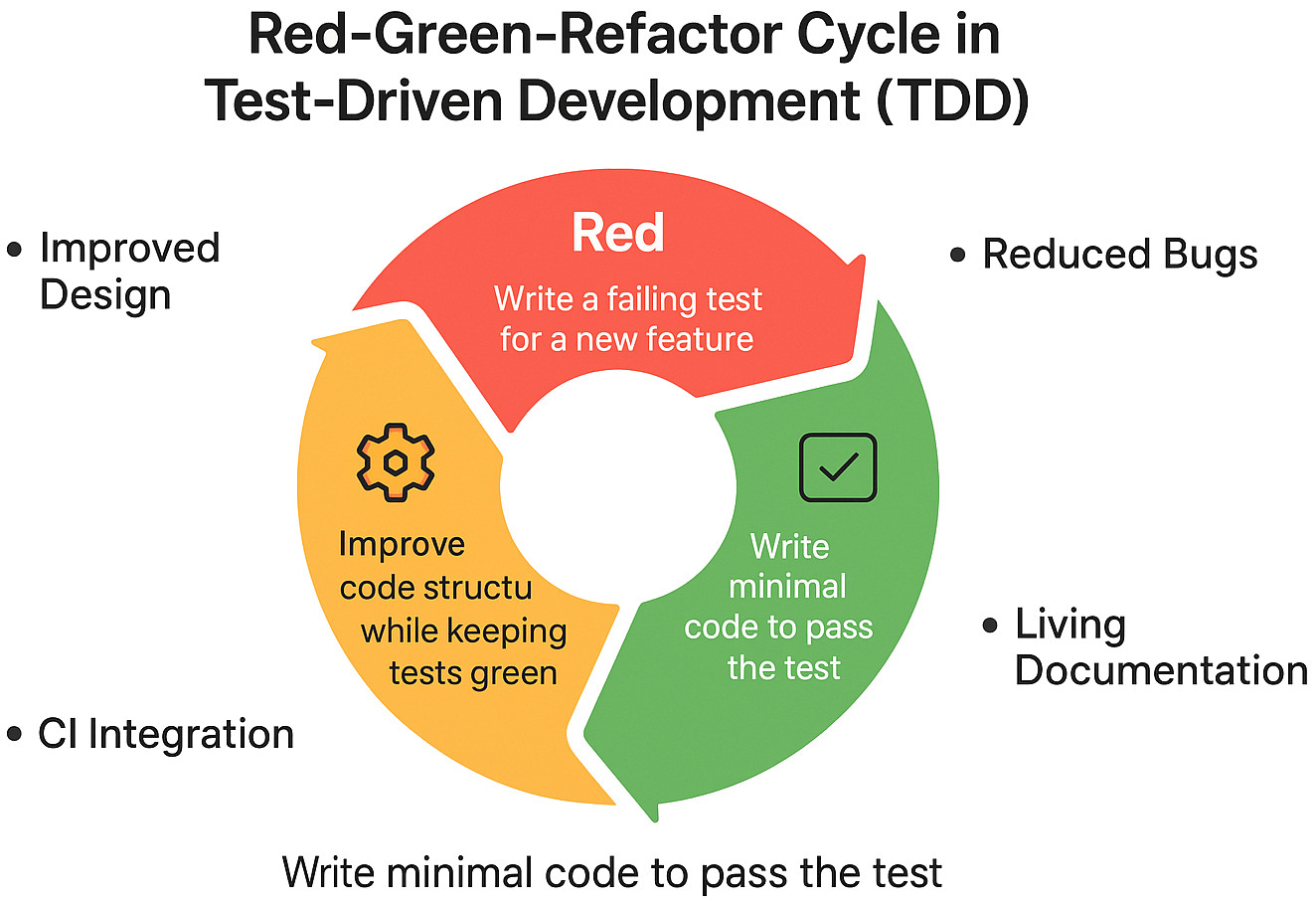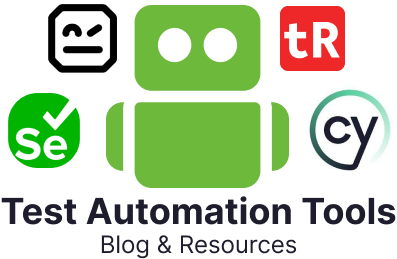Developing reliable, maintainable, and error-free code is not only an objective, but a mandatory requirement in the accelerated software development world of today. By changing the traditional workflow at its foundation, the method called Test-Driven Development (TDD) helps developers achieve this. TDD emphasizes writing tests before any code is built, as compared to writing tests after the code is developed. System design, code quality, and overall development efficiency are all drastically impacted by this minor change.
Understanding Test Driven Development (TDD)
Test Driven Development (TDD) is a development strategy in which automated tests are built prior to the code implementation. It complies with a systematic cycle called Red-Green-Refactor.

- Red: Create tests that fail because the features are not yet available.
- Green: Write just enough code to pass the test.
- Refactor: Enhance the code without modifying its feature and ensure the test still passes.
By ensuring that code is only developed when a test has been created to verify it, this cycle encourages improved design and reduced errors.
Origins and Evolution of TDD
Though the idea of developing tests has been around for a while in different styles. Kent Beck’s book names “Test-Driven Development: By Example” helped to officially promote TDD in the early 2000s. As a part of the Extreme Programming (XP) movement, Beck introduced this method. TDD has slowly established itself in continuous integration (CI) workflows and Agile developments strategies.
The Benefits of Implementing Test-Driven Development (TDD)
Other than just passing tests, TDD offers a number of real benefits:
- Improved Code Quality: Your codebase is generally more modular and focused because you develop tests for each unit of code.
- Fewer Bugs: By first creating tests, bugs are detected early on, often before they expand into systematic issues.
- Refactoring Confidence: Recognizing that the test suite will detect any regressions provides developers with the confidence to refactor code.
- Living Documentation: Unit tests offer current information about how the code should function.
- Better Design: Before jumping into implementation, TDD advises developers to consider functionality and design.
The TDD Workflow: Red-Green-Refactor in Action
Let’s use a simple function to demonstrate a basic TDD example. Let us consider that we wish to build a function that returns any number’s square.
-
Write a Test (Red)
def test_square(): assert square(3) == 9
Since the function square() does not exist yet, this test will fail. -
Write minimal code to ensure the test passes (Green)
def square(x): return x * x
Now the test passes. - Refactor (if needed and where required)
No refactoring is needed in this instance because the code is clear and simple. However, in more complex situations, you might enhance naming, extract methods, or remove duplications.
Common TDD Methods: Comparing Inside-Out and Outside-In
There are two main methods for TDD implementation:
Inside-Out (Detroit School/Classicist)
The smallest functional unit is where this method starts. As you work towards the finalized product, you create unit tests. It works best for systems where test isolation is vital and business logic is well understood.
Outside-In (London School/ Mockist)
This method dives deeper into implementation details after defining high-level behavior (often with mock objects) first. It works well for aligning development with behavior-driven development (BDD) and user stories.
Agile Environments with Test-Driven Development
Agile development cycles are a natural fit for TDD. The TDD mindset is in line with agile’s commitment to regular feedback, small increment modifications, and high responsiveness to changes. Prioritizing test writing encourages rapid iteration, continuous integration, and the timely delivery of functional software.
Behavior Driven Development (BDD) and Acceptance Test Driven Development (ATDD) may be utilized in Agile teams to support TDD. These methods ensure that technical implementation and business goals are aligned by working with stakeholders to develop high-level acceptance tests.
Test Driven Development with Different Programming Languages
Any environment or platform that enables automated testing can be used to practice TDD because it is not reliant on language. Here are some examples:
- Java: Utilizing frameworks like Mockito, JUnit
- Python: With Unittest or PyTest
- JavaScript: Using Mocha, Jest
- C#: Through MSTest and NUnit
The core tenets remain the same, regardless of language: write the code, write the test, and refactor.
Common Challenges with Test-Driven Development
Despite its benefits, TDD has certain disadvantages:
- Initial Learning Curve: To become well-versed, a mindset shift and practice are vital.
- Longer Development Time: Writing tests initially demand more time, but they often result in time savings over time.
- Over-Mocking: Excessive mocking can lead to fragile tests, particularly when utilizing the outside-in method.
- Not Ideal for UI/UX Code: TDD works perfectly for code that depends heavily on logic, not always for visual or front-end elements.
While teams reported a 15-35% increase in initial development time, IBM and Microsoft case studies demonstrate that pre-release defect density decreased by 40% to 90% on projects using TDD. Also, it can be specifically difficult to implement TDD into legacy systems. Because legacy codebase often lacks a modular structure, testing them can be difficult. There are risks related to building tests in such environments, which may require extensive refactoring up front. Additionally, not every team member may be equally experienced at building unit tests, which could lead to uneven test coverage or badly written tests that don’t correctly validate the intended behavior.
TDD can also provide a false sense of security. The system does not always behave correctly from the user’s POV just because unit tests pass. TDD should not be considered as a complete testing strategy in and of itself, but rather as just one small component of it.
Best Practices for Successful TDD
Take into consideration these best practices to get the most benefit from test-driven development:
- Build brief, targeted tests: One behavior or edge case should be addressed by each test.
- Steer clear of over-engineering: Allow your tests to naturally guide your implementation.
- Utilize meaningful test names: Explains what the test is validating.
- Frequently refactor: Clean code is maintainable code.
- Integrate with CI/CD: Ensure that every commit causes your test suite to be executed automatically.
Furthermore, be sincere about adhering to the Red-Green-Refactor cycle without eliminating any steps. Prior to writing tests, avoid writing extensive production code. While mocking and stubbing can isolate unit tests, using them excessively can lead to test suites that are brittle and challenging to maintain. To efficiently handle a range of input/output scenarios, consider using parameterized tests.
Encourage a culture of code reviews in team environments that include close examination of tests. Tests that are poorly written may pass without actually validating behavior. As your codebase expands, investing time building clean, expressive, and maintainable tests will pay off multiple times over. Finally, to ensure a holistic validation pipeline that covers your application’s logic and end-to-end behavior, implement TDD with integration and acceptance tests.
Is Test-Driven Development a Good Fit for You?
Although it’s not a panacea, test-driven development can drastically improve the software’s quality and maintainability, if used thoughtfully. TDD provides an organized and iterative route to better software, regardless of whether you’re working in a cross-functional Agile team, building a critical backend system, or experimenting with new APIs.
Start with small steps if you’re new to TDD. Select a section of your codebase that is prone to bugs or frequent modifications. Execute a few tests, get an understanding of the process, and then optimize. Mastery demands regular practice and time, just like any other techniques.
